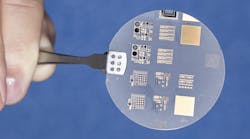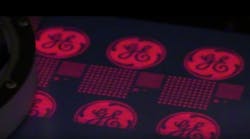This article was published in the October 2012 issue of LEDs Magazine.
View the Table of Contents and download the PDF file of the complete October 2012 issue, or view the E-zine version in your browser.
+++++
Phosphor-converted white LEDs are ubiquitous today, although there is still significant room from improvement in terms of optical efficiency. Packaged LED manufacturers spend considerable time constantly improving all elements of component design, manufacturing, and packaging to optimize efficiency. In this article, we will cover the latest trends in chips, optics and package architecture. These details are increasingly important all of the way through the solid-state lighting (SSL) supply chain and even lighting designers and specifiers need to understand the unique properties of LED sources.
These early LEDs were acceptable for some applications, such as indicator lights, but without higher power and a blue source, they were not suitable for general, white-lighting purposes. Fortunately, a breakthrough from Shuji Nakamura (while at Nichia) in the early 1990s solved this problem. He developed nitride-based semiconductors – specifically those using indium gallium nitride (InGaN) – which allowed blue light to be produced.
After blue was available, it was found that green could be made with InGaN materials. There was also a substantial effort to improve red LEDs (e.g., for stop lights and tail lamps on cars), and some design teams pursued white-light solutions using RGB mixing (for instance, using AlGaInP to make red and InGaN to make green and blue). For many general lighting applications, however, the RGB approach has been abandoned in favor of InGaN-based, blue-LED-chip-plus-phosphor (typically yttrium aluminium garnet (YAG) materials) solutions. The phosphor-converted LEDs are simpler, more robust devices when white light at a single color temperature is desired, requiring no active color feedback electronics, and fewer individual LED chips.
Configurations
For InGaN-based LEDs, the GaN-type epitaxial layers (crystalline deposition layer – in this case the GaN materials – over a crystalline substrate that it is in registry with) are typically grown on a sapphire substrate, or in some cases silicon carbide. Sapphire is chosen due to its wide availability, crystalline symmetry, ease of handling, and transparency.
LED efficiency
LED efficiency has multiple components. It can be divided up into at least five parts: ηelectrical , the electrical contacts and resistance losses; ηIQE , the internal quantum efficiency of the active layer; ηLex, the light extraction from the chip; ηphosphor , the phosphor conversion efficiency when making white LEDs; and ηpackage, the light extraction out of the LED package. The total wall plug efficiency of a blue LED without phosphors, for instance, can be expressed as follows:
The total white-LED efficiency also includes the phosphor conversion, and is more complex, since only a portion of the LED’s flux is converted. Devices using a flip chip with the laser lift-off technique and a proprietary, high-reflectivity silver (Ag) layer as a mirror (pioneered by Osram) have been shown to give a total wall plug efficiency of 53.3% for a blue LED.
Light extraction efficiency
Thus, this angle will change depending on the chip’s index and that of the surrounding medium. Some common chip materials include: crystalline silicon (Si) with an index in the 3.0-4.0 range, GaN with an index of 2.3, and sapphire with an index of 1.77.
If the chip material is Si and it is placed in air, then θTIR = 15.3° using nchip = 3.8. θTIR defines the half angle of a cone, and rays outside of this escape cone in the Si can become trapped in the chip and never get out. For a rectangular solid chip, there may be up to six escape cones depending on whether or not transmissive materials are used above and below the p-n junction. However, one of the cones typically is in the direction of a substrate and rays that would have escaped are either absorbed or reflected.
One of the escape cones for a Si chip in air is shown in Fig. 2a. Rays above the cone’s half-angle (given by θTIR) totally internally reflect and then stay in the chip. One way to improve the situation is to immerse the chip in a surrounding index that is higher than air. Typically, the material used is silicone, with an index of roughly 1.47. Immersing the Si chip in silicone increases the escape cone’s half angle to 22.8°. A dome larger than the chip is typically used, since it results in very little refraction (ray deviation) and therefore does not cause further TIR issues.
The problem shown here can also be thought of as an étendue mismatch between the source and the index we would like to put light into—namely, air. Étendue is a preserved quantity in an optical system and is given by:
This equation implies that in an optical system, the source size, its projected angular extent, and its surrounding refractive index define a constant étendue value. If we try to squeeze this étendue into an area of the same size, but with a lower refractive index, and the projected solid angle of the source is already full (as in this case), there will be angular clipping of the flux. This is exactly what we see going on here.
Étendue also has other consequences. For instance, if we want to collimate light from a Lambertian source (like a flat cast LED), it shows mathematically that the output aperture will have to increase in area as the angular extent of the light decreases. If you don’t increase your aperture size, then light will be lost due to spatial clipping. If you like small aperture sizes, it pays to avoid diluting the source étendue if possible.
As shown in Fig. 2b, we immersed the chip in a lower index material and allowed the output surface to grow in order to ease the étendue mismatch. Another approach to help this problem, now standard in the backlight display industry, is to use scattering (in this case textured) surfaces in combination with light-ray recycling. This approach is utilized in many flip-chip GaN systems, including those with laser lift-off removal of the sapphire layer.
In Fig. 3a, we show a 2D image of how this type of recycling system works. Light is generated at the InGaN quantum well junction layer. If it goes upward, it encounters a textured interface at the GaN/silicone boundary and may refract and escape. If not, it is reflected downwards at a randomized angle and then encounters the highly reflective Ag surface at the bottom of the p-layer and goes through the chip again. Fig. 3b shows a 3D view of the chip structure with an example randomized texture. One consequence of this approach is that an electrode is required on the top surface.
Phosphor efficiency
Another critical aspect of phosphor-based white LEDs is the phosphor itself. In modeling phosphor materials, there are many items which must be measured or inferred. For instance, one needs to characterize the absorption spectrum of the phosphor particle, the emission spectra, the quantum yield (or excitation spectrum), the mean free path of the phosphor, the particle size distribution, and the intensity distribution from interactions that do not result in a conversion.
Another issue related to phosphor efficiency is the geometric configuration one should use. Traditional LEDs included a phosphor slurry sitting in a cup as shown in Fig. 4a. Because of the different path lengths from the blue chip through the phosphor, this configuration tends to give an intensity distribution that is bluer in the center and more yellow at higher angles.
Fig. 4b shows a conformal-coating phosphor that follows the chip shape more carefully and gives a much more uniform color over all angles. This type of LED has now become standard and has the added benefit of preserving the source’s étendue better (it does not increase the effective source size very much compared to other phosphor approaches).
Fig. 4c shows a third approach that some design teams are now working on—remote phosphors. There are many remote phosphor configurations possible, but in the example shown, there is a hollowed-out transparent dome placed over a blue LED and a yellow phosphor coating is applied to the inside surface of the dome. This approach tends to have even better color mixing than conformal coatings; however, the source size may be increased dramatically, thus diluting the source étendue.
Package extraction efficiency
There are two primary types of LED package architectures that have emerged over the years: dome and flat cast. Additionally, there are some LEDs that are sold with more exotic optics incorporated on top of the chip – for instance, LEDs designed to make a batwing distribution. For the most part, the LED manufacturers supply dome or flat cast LED sources, and optical designers choose from an array of off-the-shelf output optics or design their own optic implementations.
Coupling to an optical system
To explore the étendue issue more closely, consider the following example: a square LED chip that is 1×1 mm emitting green light with and without a dome made of silicone with an index of 1.47. In Fig. 5, we show the domed system geometry on the left and the relative source flux exiting the dome on the first pass to the right. A relatively modest dome radius of 1mm allows >99.9% of the chip flux to exit.
Next, let’s set the dome radius to 1mm and then defocus all of the exiting rays back to a plane of best virtual focus. In this example, the best focus occurs at a distance of 0.17 mm above the emitting surface of the chip (that is, away from the chip and towards the dome’s vertex). In Fig. 6, we show the illuminance distribution at the surface of the LED without a dome on the left, and the illuminance distribution at the best focus plane for the domed LED on the right.
In the center of the two raster images, the en-squared flux is plotted for both configurations. The chip without a dome shows a sharp cut-off at a 0.5-mm half-length as expected. However, the effective size of the source is increased dramatically for the domed LED. The 98% en-squared energy occurs at 1.1-mm half-length. This means that the effective source area has roughly quadrupled. If you want to capture all the light in your optical system, the size of your optics must increase to accommodate this.
In this article, we have delved briefly into the history of LEDs and the main design configurations used. Additionally, we have looked into the sources of LED efficiency loss and explored design techniques for increasing the efficiency of the light extraction from the chip, phosphor, and package.














